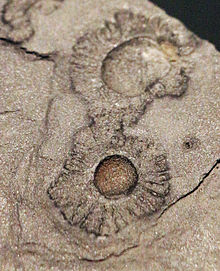Francevillian biota

The Francevillian biota (Also referred to as Gabon macrofossils, Gabonionta or Francevillian group fossils) are a collection of 2.1-billion-year-old
| Part of a series on |
| The Francevillian basin |
|---|
 |
Morphology
The structures are up to 17 centimetres (6.7 in) in size.[6][7] They form flattened disks with a characteristic morphology, including circular and elongated specimens. A spherical to ellipsoidal central body is bounded by radial structures. The structures show three-dimensionality and purportedly coordinated growth.[6]
A newer 2014 study by El Albani et al. describes multiple types of structures with different morphologies. There are convoluted tubes, and "string of pearls"-like structures that terminate in a "flower". This is similar to
In 2023, more structures were studied by El Albani and colleagues, which were characterized by the authors as
Locality

The findings come from shales of the
Interpretations
In describing the structures, El Albani and colleagues described them as colonial organisms with possible affinities to
Another view, held by
See also
References
- ^ PMID 24963687.
- ^ S2CID 258360867.
- ^ Experiment Life – the Gabonionta. (Press Release). 4 March 2014. Naturhistorisches Museum Wien
- ^ S2CID 37069547.
The identity of the [Francevillian biota] macrostructures remains unknown and their biogenicity is questionable
- ^ S2CID 257761993.
- ^ S2CID 4331375.[permanent dead link]
- ^ "Une vie complexe il y a 2 milliards d'années : l'hypothèse se confirme !". futura-sciences.com (in French). 26 June 2014. Retrieved 18 November 2017.
- .
- ISSN 0883-1351.
- S2CID 134362289.
- .

